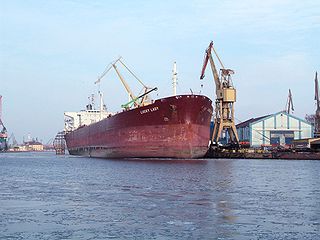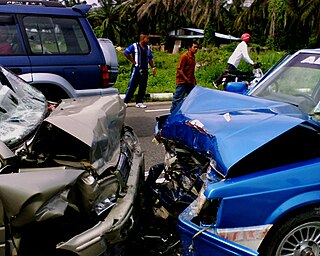Significance
Although the stevedore would have foreseen that careless loading might cause some damage to the workers, cargo, or the ship, it was beyond probability that the actual total loss would occur, yet the defendant was held fully liable.
The Re Polemis decision was disapproved of, and its test replaced, in the later decision of the Privy Council in the Wagon Mound (No. 1) [1961]. [2] Re Polemis has yet to be overruled by an English court and is still technically "good law". However, it was disapproved by the Privy Council, whose decisions are not binding but are strongly persuasive on English courts. The upshot is that the strict liability principle in Re Polemis has not been followed, and the case may be considered "bad law". [3]
- The move away from strict liability meant that it was more likely that a defendant would not be liable, and the Scots court in Hughes v Lord Advocate tried to find a middle way. It created the concept of "foreseeability of the class of harm"; that is, one need not foresee the actual harm, provided one could foresee a "class of harm" into which the unforeseeable result fell. Happily, this allowed two young boys who had suffered burns to be compensated; but in the English case of Doughty v Turner Manufacturing [4] [5] the claimant was less favoured: this factory worker who was injured in an eruption when a fellow employee careless dropped a lid into a vat of hot liquid was unable to recover as the court held that whist "splashing" was foreseeable, the actual "eruption" fell outside the "foreseeable class of harm".
- Since 1932, defendants will be liable in negligence only if could have been foreseen that the breach of the duty of care towards the claimant would cause loss, damage or injury.
An exception that still applies is the talem qualem rule, (or "eggshell skull rule"), which means "you take your victim as you find him"; but this applies ONLY to personal injury, as in Smith v Leech Brain . [6]
Negligence per se is a doctrine in US law whereby an act is considered negligent because it violates a statute. The doctrine is effectively a form of strict liability.
Negligence is a failure to exercise appropriate and/or ethical ruled care expected to be exercised amongst specified circumstances. The area of tort law known as negligence involves harm caused by failing to act as a form of carelessness possibly with extenuating circumstances. The core concept of negligence is that people should exercise reasonable care in their actions, by taking account of the potential harm that they might foreseeably cause to other people or property.
In law and insurance, a proximate cause is an event sufficiently related to an injury that the courts deem the event to be the cause of that injury. There are two types of causation in the law: cause-in-fact, and proximate cause. Cause-in-fact is determined by the "but for" test: But for the action, the result would not have happened. The action is a necessary condition, but may not be a sufficient condition, for the resulting injury. A few circumstances exist where the but-for test is ineffective. Since but-for causation is very easy to show, a second test is used to determine if an action is close enough to a harm in a "chain of events" to be legally valid. This test is called proximate cause. Proximate cause is a key principle of insurance and is concerned with how the loss or damage actually occurred. There are several competing theories of proximate cause. For an act to be deemed to cause a harm, both tests must be met; proximate cause is a legal limitation on cause-in-fact.
This article addresses torts in United States law. As such, it covers primarily common law. Moreover, it provides general rules, as individual states all have separate civil codes. There are three general categories of torts: intentional torts, negligence, and strict liability torts.
Bolton v. Stone[1951] AC 850, [1951] 1 All ER 1078 is a leading House of Lords case in the tort of negligence, establishing that a defendant is not negligent if the damage to the plaintiff was not a reasonably foreseeable consequence of his conduct. The plaintiff was hit by a cricket ball which had been hit out of the ground; the defendants were members of the club committee.

English tort law concerns the compensation for harm to people's rights to health and safety, a clean environment, property, their economic interests, or their reputations. A "tort" is a wrong in civil law, rather than criminal law, that usually requires a payment of money to make up for damage that is caused. Alongside contracts and unjust enrichment, tort law is usually seen as forming one of the three main pillars of the law of obligations.

Overseas Tankship (UK) Ltd v The Miller Steamship Co or Wagon Mound , is a landmark tort case, concerning the test for breach of duty of care in negligence. The Judicial Committee of the Privy Council held that loss will be recoverable where the extent of possible harm is so great that a reasonable man would guard against it.
In tort law, an intervening cause is an event that occurs after a tortfeasor's initial act of negligence and causes injury/harm to a victim. An intervening cause will generally absolve the tortfeasor of liability for the victim's injury only if the event is deemed a superseding cause. A superseding cause is an unforeseeable intervening cause. By contrast, a foreseeable intervening cause typically does not break the chain of causality, meaning that the tortfeasor is still responsible for the victim's injury—unless the event leads to an unforeseeable result.
Negligence in employment encompasses several causes of action in tort law that arise where an employer is held liable for the tortious acts of an employee because that employer was negligent in providing the employee with the ability to engage in a particular act. Four basic causes of action may arise from such a scenario: negligent hiring, negligent retention, negligent supervision and negligent training. While negligence in employment may overlap with negligent entrustment and vicarious liability, the concepts are distinct grounds of liability. The doctrine that an employer is liable for torts committed by employees within the scope of their employment is called respondeat superior.
Causation is the "causal relationship between the defendant's conduct and end result". In other words, causation provides a means of connecting conduct with a resulting effect, typically an injury. In criminal law, it is defined as the actus reus from which the specific injury or other effect arose and is combined with mens rea to comprise the elements of guilt. Causation only applies where a result has been achieved and therefore is immaterial with regard to inchoate offenses.

Canadian tort law is composed of two parallel systems: a common law framework outside Québec and a civil law framework within Québec. Outside Québec, Canadian tort law originally derives from that of England and Wales but has developed distinctly since Canadian Confederation in 1867 and has been influenced by jurisprudence in other common law jurisdictions. Meanwhile, while private law as a whole in Québec was originally derived from that which existed in France at the time of Québec's annexation into the British Empire, it was overhauled and codified first in the Civil Code of Lower Canada and later in the current Civil Code of Quebec, which codifies most elements of tort law as part of its provisions on the broader law of obligations. As most aspects of tort law in Canada are the subject of provincial jurisdiction under the Canadian Constitution, tort law varies even between the country's common law provinces and territories.
In English tort law, an individual may owe a duty of care to another, in order to ensure that they do not suffer any unreasonable harm or loss. If such a duty is found to be breached, a legal liability will be imposed upon the tortfeasor to compensate the victim for any losses they incur. The idea of individuals owing strangers a duty of care – where beforehand such duties were only found from contractual arrangements – developed at common law, throughout the 20th century. The doctrine was significantly developed in the case of Donoghue v Stevenson, where a woman succeeded in establishing a manufacturer of ginger beer owed her a duty of care, where it had been negligently produced. Following this, the duty concept has expanded into a coherent judicial test, which must be satisfied in order to claim in negligence.
Causation in English law concerns the legal tests of remoteness, causation and foreseeability in the tort of negligence. It is also relevant for English criminal law and English contract law.
In English law, remoteness between a cause of action and the loss or damage sustained as a result is addressed through a set of rules in both tort and contract, which limit the amount of compensatory damages available for a wrong.

Overseas Tankship (UK) Ltd v Morts Dock and Engineering Co Ltd, commonly known as Wagon Mound , is a landmark tort law case, which imposed a remoteness rule for causation in negligence. The Privy Council held that a party can be held liable only for loss that was reasonably foreseeable. Contributory negligence on the part of the dock owners was also relevant in the decision, and was essential to the outcome, although not central to this case's legal significance.

Hughes v Lord Advocate[1963] UKHL 31 is an important Scottish delict case decided by the House of Lords on causation. The case is also influential in negligence in the English law of tort.

Page v Smith[1995] UKHL 7 is a decision of the House of Lords. It is part of the common law of England and Wales.
Smith v Leech Brain & Co [1962] 2 QB 405 is a landmark English tort law case in negligence, concerning remoteness of damage or causation in law. It marked the establishment of the eggshell skull rule, the idea that an individual is held responsible for the full consequences of his negligence, regardless of extra, or special damage caused to others.
Doughty v Turner Manufacturing is a 1964 English case on the law of negligence.

Chapman v Hearse is a significant case in common law related to duty of care, reasonable foreseeability and novus actus interveniens within the tort of negligence. The case concerned three parties; Chapman who drove negligently, Dr Cherry who assisted him on the side of the road, and Hearse who, in driving negligently, killed Dr Cherry while he was assisting Chapman. In the Supreme Court of South Australia, Hearse was found liable for damages to Dr Cherry's estate under the Wrongs Act 1936. Hearse sought to reclaim damages from Chapman due to his alleged contributory negligence; Chapman was found liable to one quarter of the damages. Chapman appealed the case to the High Court of Australia on August 8, 1961, but it was dismissed as the results of his negligence were deemed reasonably foreseeable. A duty of care was established between Chapman and the deceased and his claim of novus actus interveniens was rejected. Dr Cherry was considered a 'rescuer' and his respective rights remained.






